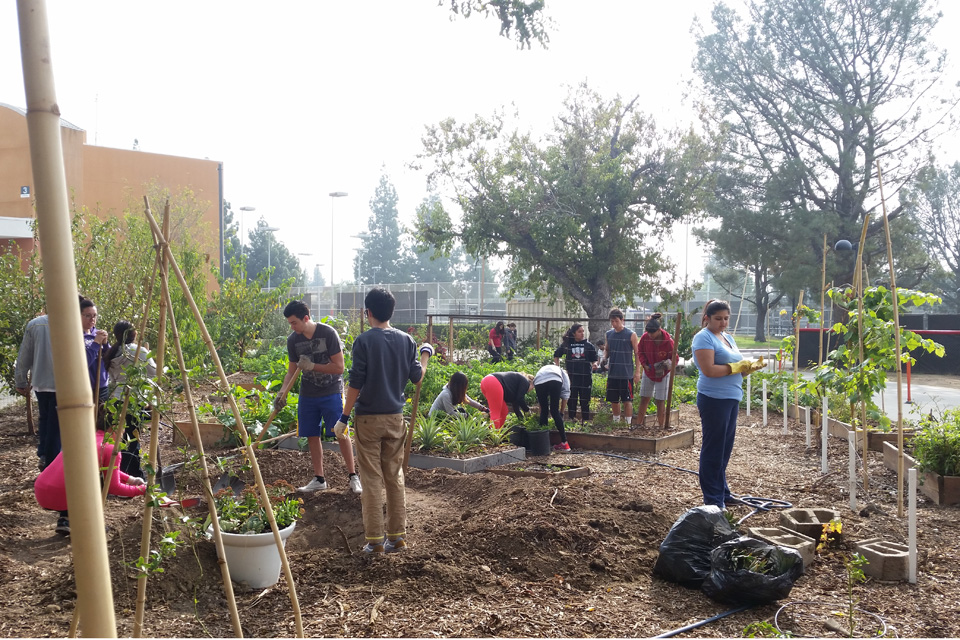

CSUN volunteers help add more plants to the campus food garden on Sustainability Day, in October 2015. Photo by Lee Choo.
After years of planning and contributions from dozens of faculty and staff members across campus, California State University, Northridge has earned a stellar ranking from the nation’s largest organization for sustainability in higher education.
Just in time for Earth Day, this month the Association for the Advancement of Sustainability in Higher Education (AASHE) awarded CSUN a gold rating in its Sustainability Tracking, Assessment & Rating System (STARS). CSUN’s gold rating is the highest in the California State University system under the current points system. It is the first time the university has completed the very complex and rigorous STARS application.
“Universities use the rating to identify areas where they can improve, and give an idea of all the things that they could do in the area of sustainability,” said Helen Cox, faculty in the Department of Geography and director of the CSUN Institute for Sustainability.
The Princeton Review also uses the STARS ratings as a basis for its list of “Green Colleges,” and the Sierra Club uses the ratings for its list of “Cool Schools,” Cox said.
“Students are increasingly looking at how green colleges are,” Cox said. “Students are very aware of the state that the planet is in, environmentally and from a resource perspective, with climate change and the general health of the oceans. More students in high school are paying attention to those things, and when they look at colleges, they look for activities that they can do related to sustainability. We’ve had students tell us that they’ve come here because they can minor in sustainability.”
The rating system is unique, Cox said, because campus sustainability often is measured only in terms of operations — such as water use and energy efficiency in buildings — but STARS measures a host of factors, including curriculum, campus activities, community partnerships and investments in addition to operations.
More than 750 colleges and universities in 24 countries have registered with the STARS rating system, according to AASHE. Of those, more than 380 institutions have achieved a gold, silver or bronze rating or recognition as a “STARS Reporter.”
CSUN scored highly for its curriculum aspects, including the large number of courses that address sustainability issues, as well as the myriad ways students can explore sustainability as interns, through research and with campus-improvement projects. The university also scored well in the area of campus engagement, including peer-to-peer education and student ambassadors through A.S. Recycling. In addition to energy efficiency, highlights of campus operations included grounds management such as drought-tolerant landscaping.
CSUN distinguished itself from other CSUs and achieved the gold rating by focusing on campuswide sustainability efforts, Cox said.
“President Harrison asked us to write a plan for sustainability when she first arrived [in 2012], which really helped us focus our efforts and expand our activities,” she said. “Previously, we had a group called the Green Core Team for many years, but we didn’t have the large campus buy-in that we’ve had since President Harrison arrived. She’s very passionate about this issue. She’s been able to expand the reach across the whole university.”
The STARS application involved a survey with hundreds of questions that required about six months of data gathering to complete, said Austin Eriksson, CSUN sustainability program manager, who spearheaded the application. About 50 people across campus gathered the requested information, and CSUN submitted its application to AASHE in January, Eriksson said.
“This is the first time we’ve submitted the survey, and we hit gold,” he said. “We’ve never had a formalized way of tracking our progress. By doing the survey, we can establish a baseline and measure our progress. It’s a huge help for planning our sustainability priorities and strategies as we move forward. The gold rating is valid for three years, and after that point we will need to give an update on our progress.”
With the gold rating under its belt, the university’s next step will be to reduce greenhouse gas emissions as part of its climate action plan, according to Eriksson and Cox.
In October, President Harrison joined a group of 10 university presidents in signing a pact as part of the American College and University Presidents’ Climate Commitment, working with the nonprofit organization Second Nature. Through this commitment, the presidents pledged to improve their universities’ practices to reduce the emission of harmful greenhouse gases as well as adapting to a constantly changing climate.
“We have a long way to go in our greenhouse gas emissions, because we don’t generate most of our own electricity,” Cox said. “Most of it comes from the local utility company. Also, the way that most people get to campus — by driving their own cars — contributes to our high emissions. Those are the biggest things we need to address.”
To read CSUN’s STARS rating report or for more information about the rating system, visit the STARS website.